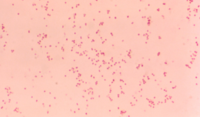
Photo from wikipedia
Moraxella catarrhalis is a symbiotic as well as mucosal infection-causing bacterium unique to humans. Currently, it is considered as one of the leading factors of acute middle ear infection in… Click to show full abstract
Moraxella catarrhalis is a symbiotic as well as mucosal infection-causing bacterium unique to humans. Currently, it is considered as one of the leading factors of acute middle ear infection in children. As M. catarrhalis is resistant to multiple drugs, the treatment is unsuccessful; therefore, innovative and forward-thinking approaches are required to combat the problem of antimicrobial resistance (AMR). To better comprehend the numerous processes that lead to antibiotic resistance in M. catarrhalis, we have adopted a computational method in this study. From the NCBI-Genome database, we investigated 12 strains of M. catarrhalis. We explored the interaction network comprising 74 antimicrobial-resistant genes found by analyzing M. catarrhalis bacterial strains. Moreover, to elucidate the molecular mechanism of the AMR system, clustering and the functional enrichment analysis were assessed employing AMR gene interactions networks. According to the findings of our assessment, the majority of the genes in the network were involved in antibiotic inactivation; antibiotic target replacement, alteration and antibiotic efflux pump processes. They exhibit resistance to several antibiotics, such as isoniazid, ethionamide, cycloserine, fosfomycin, triclosan, etc. Additionally, rpoB, atpA, fusA, groEL and rpoL have the highest frequency of relevant interactors in the interaction network and are therefore regarded as the hub nodes. These genes can be exploited to create novel medications by serving as possible therapeutic targets. Finally, we believe that our findings could be useful to advance knowledge of the AMR system present in M. catarrhalis.
Journal Title: Briefings in functional genomics
Year Published: 2023
Link to full text (if available)
Share on Social Media: Sign Up to like & get
recommendations!